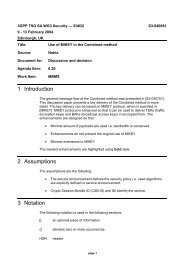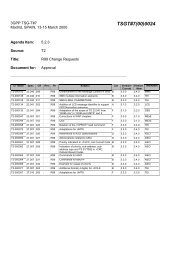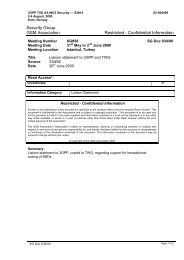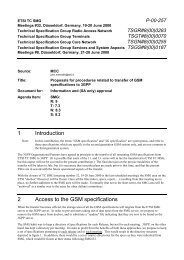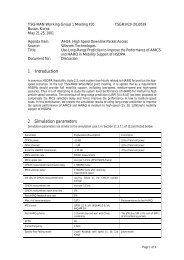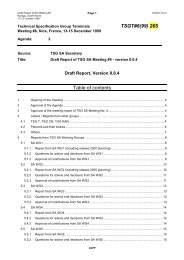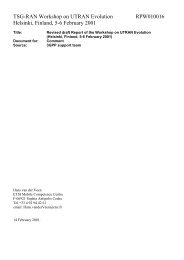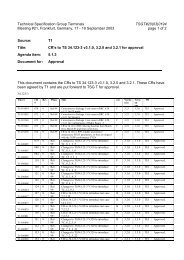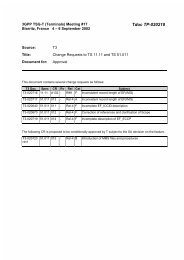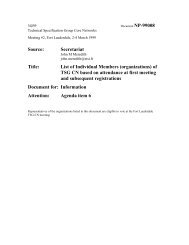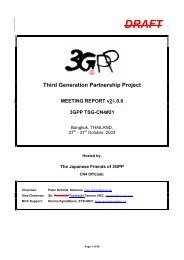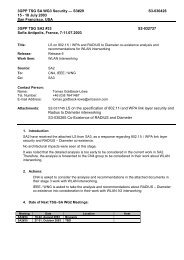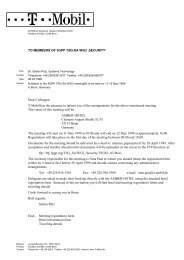2. OMA/WPKI - 3GPP
2. OMA/WPKI - 3GPP
2. OMA/WPKI - 3GPP
You also want an ePaper? Increase the reach of your titles
YUMPU automatically turns print PDFs into web optimized ePapers that Google loves.
<strong>3GPP</strong> TSG SA WG3 Security — S3#26 S3-020637<br />
19 – 22 November 2002<br />
Oxford, UK<br />
Source: Siemens<br />
Title: Work in <strong>OMA</strong> and W3C on certificate handling<br />
Document for: Discussion<br />
Agenda Item: 7.7 (Support for subscriber certificates)<br />
________________________________________________________________<br />
Abstract<br />
This contribution is to inform the reader about completed and ongoing activities in <strong>OMA</strong> and<br />
W3C on issues of relevance to the work item “subscriber certificates”. The contribution highlights<br />
that both, the <strong>WPKI</strong> defined by <strong>OMA</strong> and XKMS being defined by W3C provide means<br />
for a mobile client to request a certificate from a registration authority. In order to secure the<br />
certificate request, some bootstrapping information is required. This contribution is to be<br />
seen in conjunction with a companion contribution from Siemens, also submitted to SA3#26,<br />
where it is argued that there is no need for <strong>3GPP</strong> to attempt defining their own certificate request<br />
procedures, but that <strong>3GPP</strong> should provide means to solving the bootstrapping problem.<br />
1. Introduction<br />
There is significant demand to use certificate based trust services via wireless devices to access<br />
Internet services. An important prerequisite to use such services is the ability of the<br />
wireless device to obtain a suitable certificate. Several initiatives aim to provide this prerequisite<br />
in a lightweight manner that is appropriate for wireless environments, e.g. the Open Mobile<br />
Alliance (<strong>OMA</strong>) and the World Wide Web Consortium (W3C).<br />
The <strong>OMA</strong> specifies the Wireless Application Protocol (WAP) standards, currently in version<br />
<strong>2.</strong>0. The WAP Public Key Infrastructure (<strong>WPKI</strong>) specification among other things describes<br />
how to obtain wireless client certificates. The W3C specifies several security related Extended<br />
Markup Language (XML) based standards. The XML Key Management Specification<br />
(XKMS) among other things details how to request certificates in a client-friendly manner.<br />
This article summarises the <strong>WPKI</strong> specification, as defined by the <strong>OMA</strong> and the XKMS draft,<br />
as defined by the W3C, focusing on the certificate request procedure and its prerequisites. It<br />
also sketches the current state of discussion in both fora regarding these matters.<br />
<strong>2.</strong> <strong>OMA</strong>/<strong>WPKI</strong><br />
The <strong>OMA</strong> (former WAP Forum) has published four wireless security standards:<br />
1. The Wireless Transport Layer Security (WTLS) is a PKI-enabled transport-level security<br />
protocol based on TLS. It has been adapted to low-bandwidth air interfaces in wireless<br />
networks. In WAP <strong>2.</strong>0 also plain TLS profiled for WAP may be used.
<strong>2.</strong> The WML Script Crypto API (WMLSCrypt) provides digital signature functionality. It allows<br />
to employ WIM services. Further functions like encryption are currently being defined.<br />
ECMA Script Crypto Object is currently profiled for use in WAP. This will include<br />
functions for key generation, and certificate handling.<br />
3. The WAP Identity Module (WIM) is a tamper resistant unit in the WAP device, commonly<br />
implemented using smart cards. It stores key material and provides cryptographic computation<br />
services. On board key generation mechanisms and provisioning of key assurance<br />
information that proves a key was generated on a WIM are currently being specified.<br />
4. The Wireless Application Protocol PKI (<strong>WPKI</strong>) is a wireless adaptation of a traditional PKI<br />
for mobile environments. Figure 1 below sketches the basic <strong>WPKI</strong> components and functionality.<br />
(1) Certificate<br />
Signing<br />
Request<br />
• WMLSCrypt<br />
WTLS, TLS<br />
WIM<br />
Client (EE)<br />
(4) Obtain<br />
Certificate<br />
Location<br />
wireless wired<br />
PKI Portal (RA)<br />
WAP Gateway<br />
/ Proxy<br />
(2) Request<br />
Certificate<br />
WTLS / TLS TLS / SSL<br />
CA<br />
Cert<br />
(5) Send<br />
Document,<br />
Signature and<br />
Certificate Location<br />
WTLS / TLS TLS / SSL<br />
Figure 1: Wireless Application Protocol (WAP) <strong>2.</strong>0 PKI<br />
(3) Post<br />
Certificate<br />
CA<br />
PKI Directory<br />
(6) Lookup<br />
Certificate<br />
Server<br />
It requires the same components like a traditional PKI, i.e. an End-Entity Application (EE), a<br />
Registration Authority (RA), a Certification Authority (CA) and a PKI Directory, as depicted in<br />
Figure 1. However, in <strong>WPKI</strong>, the EE and RA are implemented differently, and a new notion,<br />
referred to as the PKI Portal, is introduced. The EE in <strong>WPKI</strong> runs on the WAP device. It uses<br />
the WMLSCrypt and the WTLS API, and the WIM for key services and cryptographic operations.<br />
It is responsible for the same functions as the EE in a traditional PKI, i.e. key handling,<br />
certificate management and validation. The PKI Portal can be a dual-networked system, like<br />
a WAP Gateway. It typically functions as RA and is responsible for translating requests of<br />
WAP clients to the RA and CA. The PKI Portal interoperates with WAP devices on the wireless<br />
side and CAs on the wired network. The PKI Portal adapts the conversation with the<br />
wireless client to the capabilities of that clientFor communication with the CA the PKI Portal<br />
may use standard certificate management protocols like Certificate Management Protocol<br />
(CMP) or Certificate Management Messages over CMS (CMC), both defined by the IETF.
CA<br />
Cert<br />
Enrollment Form<br />
Name:<br />
Password:<br />
Sign&Submit<br />
WIM<br />
Client PKI Portal<br />
CA<br />
WTLS / TLS<br />
Registration Form<br />
Completed and Signed<br />
Registration Form with<br />
Appended Public Key<br />
Certificate (URL) Delivery<br />
TLS / SSL<br />
Request Certificate<br />
Figure 2: <strong>WPKI</strong> Client Signature Key Registration Process<br />
Wireless clients may register Over-the-Air (OTA) by contacting the PKI Portal (= RA). Different<br />
mechanisms are used for authentication and for signature (=non-repudiation) key certification.<br />
For authentication keys proof-of-posession is performed via (W)TLS, whereas for signature<br />
keys proof-of-posession is given via WMLScrypt SignText. The initial authentication to<br />
bootstrap certification may be supported by an existing registration, by passwords transmitted<br />
over (W)TLS, or by an existing certificate which may be a certificate on a previously registered<br />
public key or a pre-installed device certificate. The notion of a device certificate is<br />
sketched in an appendix in the <strong>WPKI</strong> standard. Device Certificates reside on a device with<br />
PKI support like the WIM. A mobile user may be supplied with initial unpersonalized certificates,<br />
e.g. by the Mobile Network Operator or SIM/WIM-Card Issuer. The RA can validate<br />
the device certificate and knows the private key is on a secure device, normally the WIM.<br />
Figure 2 sketches a typical registration information flow, if a client requests certification of a<br />
signature key. The client initiates a (W)TLS connection to a PKI Portal. The PKI Portal authenticates<br />
itself during the (W)TLS handshake and presents the client with a form to provide<br />
the registration credentials, i.e. username and password. On submission, the form is signed<br />
by the WMLSCrypt function SignText. By this, the corresponding public key gets appended<br />
automatically. The signed and completed enrollment form is returned to the PKI Portal. For<br />
registration of an authentication key the process is similar. Only here the client uses the public<br />
key to be registered in a (W)TLS handshake together with a self-signed certificate, and<br />
client is done again using a password.<br />
Client Certificates in <strong>WPKI</strong> may be delivered Over-the-Air in 3 basic manners. The CA may<br />
deliver the certificate to the Client. Here the Client must store and manage the certificate,<br />
and relaying parties get the certificate from the client. The CA alternatively may publish the<br />
certificate in a directory only, and simply indicate this fact to the client. The relaying party<br />
then must search for the certificate by the client’s public key id. As a third alternative the CA<br />
may return a Client certificate location (URL) to reduce storage and transmission bandwidth.<br />
A relaying party here can use the URL to retrieve the certificate.<br />
<strong>WPKI</strong> adapts the IETF PKIX standards for wireless environments, namely PKI protocols,<br />
certificate formats, and cryptographic algorithms and keys. It defines the PKI model and operations.<br />
<strong>WPKI</strong> supports WTLS, X.509-WAPCert and X.509-PKIX certificates. Current <strong>WPKI</strong><br />
applications are entity and message authentication for WTLS and WMLSCrypt. <strong>WPKI</strong> uses<br />
WTLS and the WMLSCrypt signText function, which allow for efficient encoding and submitting<br />
of PKI service requests. The WTLS certificate specification provides a simple certificate<br />
format in an ad-hoc encoding. The WAPCert specification provides a compact certificate profile<br />
as a sub-profile of X.509-PKIX. Both formats reduce the size as compared to standard<br />
X.509 certificates. Client certificates use X.509-PKIX format, but, as described before, those<br />
will not normally be transmitted over the air or be stored on the client.
Status validation mechanisms, like CRLs and OCSP for the wireless client are not yet specified<br />
for <strong>WPKI</strong>. To provide a work-around for the lack of client-side status validation facilities,<br />
short-lived server certificates were introduced to obviate the need for a separate revocation<br />
check. The CA authenticates a server typically for one year. The CA issues a new short-lived<br />
certificate, with a lifetime of typically 48 hours, every day of that year. For revocation the CA<br />
simply ceases issuing further short-lived certificates. The client requires a sufficiently accurate<br />
time awareness. General use of OCSP within <strong>WPKI</strong> is discussed within the <strong>OMA</strong> security<br />
group and a recent draft reflecting this discussion dates from August 200<strong>2.</strong> This draft<br />
both profiles the IETF OCSP standard for deployment in WAP and specifies OCSP piggybacking.<br />
Certificate status validation support via piggybacking OCSP responses based on an<br />
idea by R. Rivest [1] is being discussed for future <strong>WPKI</strong> versions. Here a server obtains a<br />
current OCSP status report for its certificate first, which it then submits to the wireless client<br />
together with its other authentication credentials.<br />
A <strong>WPKI</strong> roadmap with respect to XKMS is discussed within the <strong>OMA</strong> security group, who in<br />
June 2002 also has participated in the requirements engineering of XKMS. XKMS would facilitate<br />
PKI integration of mobile clients by offloading certificate handling to XKMS servers.<br />
However this requires XMLDSig support, which the <strong>OMA</strong> security group also considers. It<br />
may be of interest that several key driving persons behind both standards are the same,<br />
mostly coming from the major PKI companies, like VeriSign, Entrust and Baltimore.<br />
3. W3C/XKMS<br />
XML Key Management Specification (XKMS <strong>2.</strong>0) is developed in the W3C. It specifies protocols<br />
for distributing and registering public keys, for use in conjunction with the XML Signature<br />
specification developed jointly by the W3C and the IETF, and an anticipated companion<br />
standard for XML Encryption. A key objective of the XKMS protocol design is to minimize the<br />
complexity of client application implementations by shielding them from the complexity and<br />
syntax of the underlying PKI used to establish trust relationships. The underlying PKI may be<br />
based upon a different specification such as X.509/PKIX, SPKI or PGP. XKMS comprises<br />
two parts, the XML Key Information Service Specification (X-KISS) and the XML Key Registration<br />
Service Specification (X-KRSS).<br />
The X-KISS specification defines a protocol for a trust service that resolves public key information<br />
and validates certificates. The X-KISS protocol allows a client of such a service to<br />
delegate part or all of the required tasks. Its functions include the location of required public<br />
keys and describing the binding of such keys to identification information. For example, the<br />
key may be specified by a name only, the local trust policy of the client may require additional<br />
information in order to trust the key, or the key may be encoded in an X.509 certificate<br />
that the client cannot parse. In the case of an encryption operation the client may not know<br />
the public key of the recipient and ask the trust service to locate it.<br />
The X-KRSS specification defines a protocol for a web service that accepts registration of<br />
public key information, supports certificate revocation, and in certain cases also key recovery.<br />
In most applications, the Registration Service will provide key information to other trust<br />
services like a separate underlying PKI such as PKIX. Once registered, the public key may<br />
be used in conjunction with other web services including X-KISS.<br />
A client may request that the Registration Service bind information to a public key. The information<br />
bound may include a name, an identifier or extended attributes. The key pair to<br />
which the information is bound may be generated in advance by the client or, to support key<br />
recovery, may be generated on request by the service. In the latter case the registration protocol<br />
may also be used for subsequent recovery of a private key.<br />
The X-KRSS protocol provides for authentication of the applicant and, in the case that the<br />
key pair is generated by the client, Proof of Possession (POP) of the private key. A means of<br />
communicating the private key to the client is provided in the case that the private key is<br />
generated by the Registration Service. Currently means of registering RSA and DSA keys
are specified, as well as a framework for extending the protocol to support other cryptographic<br />
algorithms such as Diffie-Hellman and Elliptic Curve variants.<br />
CA<br />
Cert<br />
Registration<br />
Client CA<br />
Service<br />
X-KRSS Registration Request<br />
X-KRSS Registration Response<br />
Request Certificate<br />
Figure 3: X-KRSS Client Registration Process<br />
The basic X-KRSS client registration information flow is sketched in Figure 3. For the client<br />
it basically consists of a single request-response pair. The registration request message indicates<br />
the requested assertion, which the registration service should provide. The registration<br />
service may require the client to provide additional information to authenticate the request. It<br />
may require the client to provide Proof of Possession of the private key.<br />
<br />
<br />
Valid<br />
MyKeyID<br />
<br />
.... <br />
MyKeyName<br />
<br />
<br />
HMAC-SHA1 (HMAC-SHA1 ("MyRevocationPassphrase", 0x2), 0x3)<br />
<br />
<br />
<br />
<br />
<br />
<br />
<br />
<br />
<br />
<br />
<br />
RetrievalMethod<br />
<br />
<br />
Figure 4: X-KRSS Client Registration Request Example<br />
As sketched in the example in Figure 4, the client may provide a password to bootstrap the<br />
certification.<br />
The response to an X-KRSS certification request may among other things include a Key<br />
Name, Public key parameters, X509v3 certificates or certificate chains, that authenticate the<br />
specified key, an X509v2 Certificate Revocation List, a PKIX OCSP token that validates an<br />
X509v3 certificate that authenticates the key, PGP key signing data or a collection of them,<br />
and SPKI key signing data, as well as encrypted private key data.
3. Summary<br />
PKI plays an important role in meeting e- and m-commerce security requirements. <strong>WPKI</strong> is a<br />
modification of a traditional PKI. <strong>WPKI</strong> has been adapted using more efficient cryptography<br />
and data transport techniques in order to work with today’s personal wireless devices and the<br />
narrow-band wireless networks. During the <strong>WPKI</strong> client enrolment procedure, the client may<br />
submit a username and password to bootstrap the certification.<br />
XKMS is developed by the W3C. It specifies protocols for distributing and registering public<br />
keys. A key objective of the XKMS protocol design is to minimise the complexity of client application<br />
implementations by shielding them from the complexity and syntax of the underlying<br />
PKI. The XKMS Key Registration Service Specification (X-KRSS) allows clients to request<br />
enrolment from a Registration Service. During the XKMS client enrolment procedure, the client<br />
may submit a key name and a password to bootstrap the certification.<br />
4. References<br />
[1] Ronald L. Rivest, “Can We Eliminate Certificate Revocations Lists?”, in: Financial Cryptography,<br />
p. 178-183, 1998, http://citeseer.nj.nec.com/rivest98can.html<br />
<strong>WPKI</strong>-Related Standards (http://www.wapforum.org)<br />
o WAP-211-X.509 profiles the contents, formats & encoding for WAP certificates & CRLs.<br />
o WAP-198-WIM defines WIM requirements.<br />
o WAP-217-<strong>WPKI</strong> profiles the existing PKIX standards for the wireless environment.<br />
XKMS-Related Standards (http://www.w3.org/2001/XKMS)<br />
o XML Key Management Specification (XKMS <strong>2.</strong>0, 18 March 2002)<br />
o D. Eastlake, J. R., D. Solo, M. Bartel, J. Boyer , B. Fox , E. Simon. XML-Signature Syntax<br />
and Processing, World Wide Web Consortium<br />
o D. Box, D Ehnebuske, G. Kakivaya, A. Layman, N. Mendelsohn, H. Frystyk Nielsen, S<br />
Thatte, D. Winer. Simple Object Access Protocol (SOAP) 1.1, W3C Note 08 May 2000



